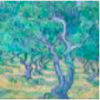Maybe, already and currently damaged brains with consequant accumulation of plaques (post 40's) possibly due to intensive lesion regeneration processes, would be likely to decrease intake of Taurine-like substances in the Olfactory Bulb. Maybe Intranasal inoculation would couteract the latency and impairment of Taurine intakes in the Olfactory Bulb.
o Taurine in the olfactory system: effects of the olfactory toxicant dichlobenil.
https://www.ncbi.nlm...6?dopt=Abstract
"In mice treated with the olfactory toxicant dichlobenil, inducing necrosis in the dorsomedial olfactory region, there was a dose-dependent decrease in the level of 14C-taurine and 3H-carnosine (derived from the precursor 3H-beta-alanine) in the olfactory bulb. The migration of 14C-taurine in the olfactory system of dichlobenil-dosed mice gradually recovered 3 - 8 weeks later although an atypical epithelium remained in the dorsomedial portion of the olfactory region. The results suggest a transient reduction of the migration of taurine in the olfactory system of mice following chemically-induced toxicity at this site."
o β-Amyloid precursor protein-like immunoreactivity is upregulated during olfactory nerve regeneration in adult rats
https://www.scienced...006899397011876
"Levels of APP-like immunoreactivity substantially increased over normal levels at six weeks when fibers of theolfactory nerve are presumably reforming normal connections. Membrane associated ‘full-length’ APP-like proteinsincreased over four-fold at six weeks post-lesion and mitral cell dendrites and perikarya displayed greater immunoreactivity than did control cases. These observations suggest that APP-like proteins increased during regeneration and recovery of the olfactory bulb neuropil and support previous speculations that APP-like proteins may be involved in neural regeneration."
o Apolipoprotein E Is Upregulated in Olfactory Bulb Glia Following Peripheral Receptor Lesion in Mice
"In our hands, apoE immunoreactivity in the normal mouse olfactory bulb was diffuse, and visible apoE-immunoreactive perikarya were rare. Procedures to increase the intensity of perikaryal staining (nickel intensification) also raised the “background” similarly, suggesting that apoE immunoreactivity was primarily present either in small processes or in the extracellular matrix. These data suggest that initially glia produce apoE immediately following lesion (hence a perikaryal localization), but then apoE is rapidly translocated to peripheral processes or an extracellular compartment or is internalized by neurons and rapidly degraded. Neurons apparently are not a major source of apoE production. The mitral neurons are found in single laminae in the bulb and it is highly unlikely that we would not have seen a labeled neuron. This suggests that intraneuronal apoE concentration in vivo is below the threshold ofdetectability by immunocytochemical techniques."
"Translocation occurs in the peripheral nervous system. Resident macrophages and monocyte-derived macrophages, at the site of injury, are reported to be the primary sources of the large quantities of apoE-containing lipoproteins. These lipoprotein particles probably scavenge cholesterol released from degenerating myelin. Scavenged cholesterol is subsequently used in membrane biosynthesis by growth cones of sprouting axons by LDL receptor-mediated endocytosis. Reactive gliosis in the CNS may be the equivalent of macrophage activity in the PNS."
"Furthermore astroglial markers are elevated in the olfactory bulb for at least 2– 4 weeks following lesion. There are no data on microglial response in an acute olfactory bulb lesion. Our observation fits well with previous descriptions of “exuberant” and probably aberrant olfactory nerve sprouting into the olfactory bulb following a reversible olfactory nerve lesion. These data suggest that processes related to degeneration could continue for several weeks following nerve lesion. A previous study suggested that apoE might be involved in regeneration because hippocampal elevation of apoE mRNA trails that of GFAP following a perforant path lesion. These data are not contradictory. If astroglia and microglia must be activated before they produce apoE, this temporal relationship is logical.
The double-labeling immunocytochemical studies confirmed that both reactive astroglia and reactive microglia produced detectable amounts of apoE following a lesion. It is fairly safe to further suggest that apoE is produced by activated microglia. In vitro studies have shown apoE production by microglia, but in vivo studies have been equivocal. This difference may represent a detection problem perhaps related to the “activated” status of astro- and microglia. We were unable to unequivocally colocalize apoE and the microglial marker in nonlesioned mice, although we did identify occasional GFAP–apoE colocalization in the same mice. Only at 3 and 7 days following olfactory nerve lesion was the cellular concentration of apoE high enough to detect when combined with glial labeling.
In vivo detection of apoE in microglia may require both upregulation of a microglial antigen (F4/80) that occurs after lesion and increased cellular concentration of apoE. Both microglia and astroglia produce apoE in the olfactory bulb but activation of glia might be required for colocalization. Injury-induced apoE production may explain variable morphological effects observed in the absence of the apoE gene. In vitro, apoE, in combination with a source of lipids, facilitates process growth . We propose that in vivo apoE is transiently increased to scavenge lipids released from degenerating processes. Much of this lipid is posited to come from degenerating axons and associated processes. This postulate is consistent with a previous study that reported impaired clearance of axonal degeneration products following injury in apoE-deficient mice. ApoE then provides those lipids to regenerating processes. In the intact CNS, inefficient recovery may be cryptic or perhaps could be compensated for by other less efficient apolipoproteins. Alternatively, only a small subset of axons may show modification, as has been reported in the PNS. Only if a lesion challenges the experimental animal will less efficient lipoprotein recycling become significant. A hypothesis of apoE participation in lipoprotein recycling is also compatible with previous observations of the effects of apoE alleles in both AD and recovery from head injury. The apoE4 allele predisposes to AD and increases the risk of developing AD after head trauma. Patients with the apoE4 allele manifest a poorer outcome following traumatic brain injury, and boxers with the apoE4 allele were at a much greater risk of developing chronic neurologic deficits than those not having the apoE4 allele. Recently, it was suggested that bloodflow (measured by fMRI) in individuals with the apoE4 allele was greater than in apoE3 homozygotes when performing the same task, suggesting some level of inefficiency in earning. If apoE is involved in efficient recycling or redistribution of lipoproteins during brain function or following injury, a lifetime of inefficient functioning associated with the apoE4 allele may result in an accentuation of mild dysfunction and an increased risk for dementia. (https://www.nejm.org...cbi.nlm.nih.gov) "
BONUS
o Are noise and air pollution related to the incidence of dementia? A cohort study in London, England
https://bmjopen.bmj....ock-system-main
"We repeated the analysis, now subclassifying dementia diagnoses recorded as Alzheimer’s disease, vascular dementia or non-specific where no further information was available. The positive associations with NO2 and PM2.5 were more consistent for Alzheimer’s disease and non-specific diagnoses. For example, patients in the top fifth exposure category of NO2 (>41.5μg/m3) were at ahigher risk of receiving an Alzheimer’s diseasediagnosis than patients inthe bottom fifth (HR=1.50, 95%CI 1.08 to 2.08). For vascular dementia, there was less evidence of consistent effects with air or noise pollution."
"Our results suggest both regional and urban background pollutants may be as important as near-traffic pollutants. Future large-scale studies will need to rely on improved recording and linkage of dementia diagnoses across electronic systems, particularly Alzheimer’s disease, where multiple sources can improve diagnostic accuracy. Since exposure is life-long, and most cases are diagnosed in later life, historical data are also ideally required to better estimate cumulative exposure over preceding decades. In conclusion, our findings add to a growing evidence base linking air pollution and neurodegeneration and should encourage further research in this area."
Edited by Moumou, 28 September 2018 - 04:42 PM.





















































